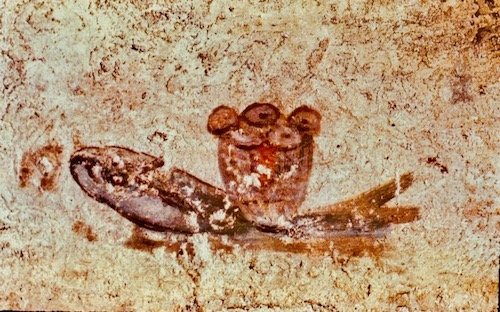Aside from the Resurrection, the one miracle that was important enough to be included in all four Gospels is the miraculous feeding of the 5,000. For to early Christians this event had great significance in the story of salvation history leading up to Jesus as the “New Moses” and the “New Manna.”
Of notable significance is this one miracle shows such clear similarities to the miraculous Manna that fell from heaven during the Exodus. In both events Moses and Jesus, along with the people, cross the sea to a deserted place. (Exodus 16) (John 6:1, Mark 8:4) In both settings it was evening and the people were hungry. (Exodus 16:6-8) (Luke 9:12) In the Exodus event God rains down flesh (quail) in the evening and in the morning bread. In the miraculous feeding of the 5,000 Jesus multiplies flesh (fish) and bread to feed the hungry crowd. Surely the crowd sees the connection between these two events when they cried out, “This is truly the Prophet, the one who is to come into the world.” (John 6:14)
It is no coincidence that at the very beginning of the sixth Chapter of the Gospel of John the Miraculous Feeding of the 5,000 happens right before Jesus is to teach His followers that “I am the bread of life. Your ancestors ate manna in the desert, but they died; this is the bread that comes down from heaven so that one may eat it and not die. I am the living bread that came down from heaven; whoever eats this bread will live forever; and the bread that I will give is my flesh for the life of the world.” (John 6:48-51)
So significant is His teaching of the Eucharist that Jesus preceded this teaching with a miracle. It is important to ponder that this miraculous multiplying of food happened once (possibly twice according to the Gospels of Matthew and Mark) and in the Exodus event it happened for 40 years. We must understand that Jesus, the “New Moses”, was setting the stage for something greater to happen. For Jesus is now claiming that He is the “New Manna”. How can we have any other way to understand this than the actual words of Jesus: “For my flesh is true food, and my blood is true drink”? (John 6:55) For the second time Jesus states “Unlike your ancestors who ate and still died, whoever eats this bread will live forever.” (John 6:58)
Reflecting further on this event and the Exodus event, we can see that in the Exodus event it was God Himself who caused the manna and quail to fall from the sky for forty years. In the New Testament event, Jesus indeed is the only one who multiplies the bread and fish but notice He does something different. He includes his disciples in not only supplying the food but He also tells them to distribute the food themselves. (Matthew 14:16-20) Jesus is taking the little bit we can offer (five loaves and two fish) and supplies what we need. I am reminded that at each Mass we see two or more people approach the altar with a small amount of bread and wine “offering” to God the little we have and allowing God to multiply the gift into the Body and Blood of Jesus. This ritual has taken place since the very early days of Christianity..
Another comparison to this event and the early Christian belief in the Eucharist is found in this 2nd century fresco called “Fractio Panis.” (Breaking of Bread) Located over the altar tomb in the catacomb of Priscilla this image gives us rich details of the Eucharistic meal at the very beginnings of Christianity. In the fresco we see seven people gathered. Present on the table is a cup of wine with two plates, one with five loaves and the other two fish. Sound familiar? (John 6:9) On each side are wicker baskets, seven in all representing the “seven basketfuls of broken pieces that were left over.” (Matthew 15:37) At the left side of the table we see the presider (priest/presbytery) with arms outstretched breaking the bread as Jesus did during the Miracle of the Feeding of the 5,000 and at the Last Supper. We also see the cup of wine as Jesus had held during the Last Supper saying: “This is my blood of the covenant”. (Matthew 26:28)
Another fresco that has equally rich connections to the Feeding of the 5,000 and the Eucharist is the “Eucharistic Bread and Fish” from the Catacomb of San Callisto. See below.
In conclusion, it is noteworthy to ponder that John Chapter 6 begins right away with the Miraculous Feeding of the 5,000 leading up to His teaching on the Eucharist. During this “Bread of Life Discourse”, the miracle of the manna in the desert from Exodus is mentioned three times! (John 6:31, 6:49, 6:48)
Let us also not forget that in Exodus God commanded to Moses to “Keep an omerful of manna for your descendants, that they may see what food I gave you to eat in the desert when I brought you out of the land of Egypt.” (Exodus 16:32) Therefore the manna was placed in a vessel as the Lord commanded and held in the Ark of the Covenant. So in the tabernacles of every Catholic Church does the “New Manna” remain waiting to feed its people.

